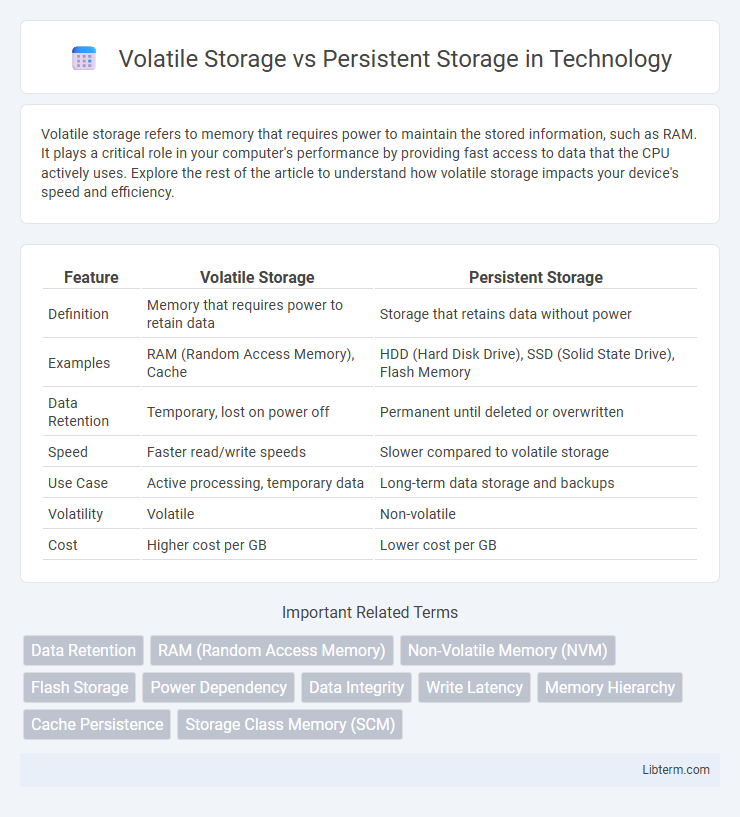Volatile storage refers to memory that requires power to maintain the stored information, such as RAM. It plays a critical role in your computer's performance by providing fast access to data that the CPU actively uses. Explore the rest of the article to understand how volatile storage impacts your device's speed and efficiency.
Table of Comparison
| Feature | Volatile Storage | Persistent Storage |
|---|---|---|
| Definition | Memory that requires power to retain data | Storage that retains data without power |
| Examples | RAM (Random Access Memory), Cache | HDD (Hard Disk Drive), SSD (Solid State Drive), Flash Memory |
| Data Retention | Temporary, lost on power off | Permanent until deleted or overwritten |
| Speed | Faster read/write speeds | Slower compared to volatile storage |
| Use Case | Active processing, temporary data | Long-term data storage and backups |
| Volatility | Volatile | Non-volatile |
| Cost | Higher cost per GB | Lower cost per GB |
Introduction to Computer Storage
Volatile storage, such as RAM, temporarily holds data and instructions actively used by the computer, losing all information when power is off. Persistent storage includes devices like hard drives and SSDs that retain data permanently, ensuring information remains available after shutdown. Understanding the distinct roles of volatile and persistent storage is crucial for optimizing computer performance and data retention strategies.
Defining Volatile Storage
Volatile storage refers to memory that requires power to maintain the stored information, such as RAM (Random Access Memory). This type of memory provides fast access speeds but loses all data when the system is powered off or restarted. Commonly used for temporary data processing and active program execution, volatile storage plays a crucial role in system performance and efficiency.
Defining Persistent Storage
Persistent storage refers to digital storage that retains data even when the power is turned off, ensuring long-term data preservation. Common types of persistent storage include hard disk drives (HDDs), solid-state drives (SSDs), and flash memory, which are essential for storing operating systems, applications, and user files. Unlike volatile storage such as RAM, persistent storage maintains information without requiring constant power, making it crucial for data integrity and system reliability.
Key Differences Between Volatile and Persistent Storage
Volatile storage, such as RAM, requires continuous power to retain data and loses information when the system is powered off, making it ideal for temporary data processing and fast access. Persistent storage includes devices like SSDs and hard drives that maintain data without power, providing long-term storage solutions for operating systems, applications, and user files. The key differences lie in data retention, speed, cost, and use cases, with volatile storage offering higher speed but no data permanence, while persistent storage ensures durability but at slower access speeds.
Common Types of Volatile Storage Devices
Common types of volatile storage devices include Dynamic Random-Access Memory (DRAM) and Static Random-Access Memory (SRAM), both essential for temporary data storage in computing systems. DRAM offers higher density and lower cost, making it ideal for main memory in desktops and laptops, while SRAM provides faster access speeds and is typically used in cache memory. These volatile storage devices require continuous power to retain data, distinguishing them from persistent storage options like solid-state drives (SSDs) and hard disk drives (HDDs).
Common Types of Persistent Storage Devices
Common types of persistent storage devices include hard disk drives (HDDs), solid-state drives (SSDs), and flash memory such as USB drives and SD cards, all designed to retain data without power. HDDs use magnetic storage to save large volumes of data cost-effectively, while SSDs offer faster access speeds and greater durability through non-volatile NAND flash memory. Flash memory devices provide portable, solid-state storage ideal for transferring data between devices or expanding storage on mobile platforms.
Use Cases for Volatile Storage
Volatile storage, such as RAM, is ideal for temporary data processing and quick access applications like running operating systems, active applications, and caching web pages due to its high-speed read/write capabilities. It is extensively used in scenarios requiring rapid data manipulation without long-term retention, including gaming, real-time data analysis, and temporary buffers in multimedia editing. Volatile storage's inefficiency in data retention during power loss makes it unsuitable for archival or persistent data requirements but optimal for tasks demanding immediate and consistent performance.
Use Cases for Persistent Storage
Persistent storage is essential for use cases that require data retention beyond power cycles, such as databases, file systems, and long-term archival of critical business information. It supports applications needing durability and consistency, including transaction processing systems, backup solutions, and cloud storage services. Enterprises rely on persistent storage for regulatory compliance, disaster recovery, and maintaining historical records to facilitate data analytics and audit trails.
Pros and Cons of Volatile vs Persistent Storage
Volatile storage, such as RAM, offers high-speed data access and efficient processing, making it ideal for temporary data storage during active tasks but loses all information when power is off, posing a risk for data persistence. Persistent storage, including SSDs and HDDs, retains data without power, ensuring long-term availability and reliability, yet it suffers from slower access speeds and limited write cycles in comparison to volatile memory. The trade-off between volatile and persistent storage lies in balancing speed and data permanence, with volatile storage excelling in performance and persistent storage prioritizing data durability.
Choosing the Right Storage Solution for Your Needs
Volatile storage, such as RAM, offers high-speed data access but loses information when power is off, making it ideal for temporary data processing and active applications. Persistent storage, including SSDs and HDDs, retains data without power, providing long-term reliability for files, databases, and system backups. Selecting the right storage solution depends on specific needs like speed requirements, data permanence, and budget constraints.
Volatile Storage Infographic

 libterm.com
libterm.com